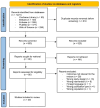Impact of Multisensor CIED-based Heart Failure Monitoring on Mortality, Heart Failure Hospitalizations and Outpatient Visits: A Systematic Review
- PMID: 40591072
- PMCID: PMC12213901
- DOI: 10.1007/s11897-025-00707-y
Impact of Multisensor CIED-based Heart Failure Monitoring on Mortality, Heart Failure Hospitalizations and Outpatient Visits: A Systematic Review
Abstract
Purpose of review: Cardiac Implantable Electronic Device (CIED)-based remote monitoring has been proposed to improve heart failure (HF) management by enabling early detection of decompensation. This systematic review evaluates the effectiveness of multisensor CIED-based monitoring in reducing mortality, HF hospitalizations, and unplanned HF outpatient visits.
Recent findings: Earlier CIED-based remote monitoring strategies were mainly based on single-sensor impedance-based algorithms, and showed limited clinical benefits. Newer multisensor CIED-based algorithms have shown promise in initial studies. However, their impact on clinical outcomes remains uncertain, and therefore current HF guidelines provide limited recommendations. Multisensor CIED-based algorithms reliably identify high-risk HF patients and their use leads to reductions in HF hospitalizations and unplanned outpatient HF visits, although prospective validation in RCTs is lacking for any of the algorithms. Standardized response strategies are needed to enhance clinical integration and generalizability. If validated, multisensor monitoring could become a key tool in HF management.
Keywords: Cardiac Implantable Electronic Devices (CIEDs); Heart Failure; HeartInsight; HeartLogic; Remote Monitoring; TriageHF.
© 2025. The Author(s).
Conflict of interest statement
Declarations. Competing Interests: The authors declare no competing interests. Conflict of interest: Bert Zwaenepoel, Annefleur Kluft, Michelle Feijen, Jan Schoones declare that they have no conflicts of interest. Ward Heggermont reports personal fees from Boston Scientific, outside the submitted work. Anastasia Egorova reports personal fees from Medtronic Trading, personal fees from Boston Scientific, personal fees from Abbott, during the conduct of the study. Saskia Beeres reports personal fees from Boston Scientific, personal fees from Medtronic Trading, during the conduct of the study; personal fees from Boehringer Ingelheim, outside the submitted work. Human and Animal Rights and Informed Consent: This article does not contain any studies with human or animal subjects performed by any of the authors.
Figures



References
-
- Savarese G, Becher PM, Lund LH, Seferovic P, Rosano GMC, Coats AJS. Global burden of heart failure: a comprehensive and updated review of epidemiology. Cardiovasc Res. 2023;118(17):3272–87. - PubMed
-
- Setoguchi S, Stevenson LW, Schneeweiss S. Repeated hospitalizations predict mortality in the community population with heart failure. Am Heart J. 2007;154(2):260–6. - PubMed
-
- McDonagh TA, Metra M, Adamo M, Gardner RS, Baumbach A, Bohm M, et al. 2021 ESC guidelines for the diagnosis and treatment of acute and chronic heart failure. Eur Heart J. 2021;42(36):3599–726. - PubMed
-
- Koehler F, Koehler K, Deckwart O, Prescher S, Wegscheider K, Kirwan BA, et al. Efficacy of telemedical interventional management in patients with heart failure (TIM-HF2): a randomised, controlled, parallel-group, unmasked trial. Lancet. 2018;392(10152):1047–57. - PubMed
-
- Inglis SC, Clark RA, McAlister FA, Ball J, Lewinter C, Cullington D et al. Structured telephone support or telemonitoring programmes for patients with chronic heart failure. Cochrane Database Syst Rev. 2010(8):CD007228. - PubMed
Publication types
MeSH terms
LinkOut - more resources
Full Text Sources
Medical
Research Materials
Miscellaneous

